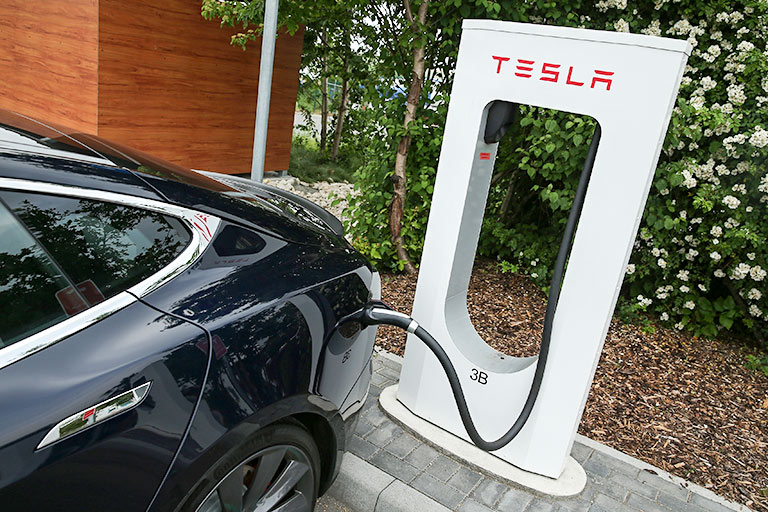An innovative new method has created the possibility of repurposing stainless steel into sustainable potassium-ion batteries
Researchers from the Chinese Academy of Sciences and Jilin University have developed an innovative, environmentally friendly method of recycling stainless steel to make novel electrodes for potassium-ion rechargeable batteries.
The team’s electrode fabrication, derived from corroded stainless steel meshes, has applications in the electronics industry, and is highly suitable for the fabrication of flexible electronic devices. Good conductivity in electrodes is crucial for applications in energy storage electronic devices.
The expected growth of portable electronics, the need for battery improvement requirements, and huge increase in the manufacture of electric vehicles – such as Tesla cars and others – in the coming years point to a need for exponential growth in renewable energy sources. In turn, this demands the development of large-scale energy storage systems for grid utilisation.
 The rising numbers of electric vehicles will require new methods of battery production to meet demand
The rising numbers of electric vehicles will require new methods of battery production to meet demand
In the past, research for large-scale energy storage solutions led to the first lithium-ion rechargeable battery commercialised by Sony in 1991. It was then when the electronics industry – and in particular the manufacture of mobile devices – was completely transformed.
“The proposed method opens new avenues for the re-use of stainless steel toward new value-added applications, which are of great importance to assist the efforts to build a resource-sustainable and environmentally friendly society.”
Prof. Xin-bo Zhang
Despite the high efficiency and suitability for small- to medium-scale applications, lithium-ion batteries have a limited life cycle. In addition, they present environmental, safety and thermal management issues. In other words, they are no longer the best available option.
Today, sustainability, as well as the high-cost of the extraction of lithium and its limited availability, have triggered researchers to look for alternatives to lithium-ion batteries. New technologies and applications demand the creation of the next generation of rechargeable super batteries, which more efficiently store renewable energy, and have better conductivity.
Sodium vs. potassium: Why potassium is a better choice
A few years ago, sodium-ion was widely considered as an alternative to replace lithium-ion batteries. Sodium, (the sixth most abundant element found in Earth’s crust), is cheaper, non-toxic, and more abundant than lithium.
Potassium, (the seventh most abundant element on Earth), is also less expensive, and far more plentiful than lithium. Potassium and sodium are chemically very similar, but besides its natural availability, low-cost, and its long life cycle, potassium is a better charge carrier in rechargeable batteries.
Sustainable solutions
Challenges in the development of advanced cathode materials, i.e. the electrode from which a conventional current leaves a polarised electrical device, and design of appropriate electrode structures, i.e. the electrical conductor of electricity for potassium-ion batteries led researchers from the Chinese Academy of Sciences and Jilin University to find a better, more sustainable alternative to lithium.
Using an innovative technique, and under the guidance of Prof. Xin-bo Zhang, a team of scientists from the Chinese Academy of Sciences and Jilin University, used corroded stainless steel meshes as iron sources. These stainless steam meshes were converted to develop stable, low-cost, high-performance cathodes for potassium-ion batteries.
“We firstly turned the meshes into flexible integrated cathodes by in-situ transformation of the corroded layer into Prussian blue (PB) nanocubes,” said Prof. Zhang.
 Jilin University in Changchun, China
Jilin University in Changchun, China
The stainless steel mesh is immersed in an acid environment, which dissolves the iron, nickel and chromium ions. These are immediately consumed by excess ferricyanide ions in the acid to form a complex salt known as cubic Prussian blue on the surface of the meshes. The nickel and chromium in stainless steel make it the perfect alloy for this process.
Prussian blue is a dark blue pigment that is found as deposits on the surface of a mesh as scaffold-like nanocubes. Thanks to this process, potassium ions can be stored in and released from these structures easily and rapidly.
“The nickel and chromium in stainless steel make it the perfect alloy for this process”
According to Prof. Zhang’s team, compared with existing cathodes of potassium-ion batteries, the as-prepared Prussian blue electrode shows excellent electric conductivity and a unique reduced graphite oxide-coated structure, which enables fast electron transfer and great cycle stability. This means increased stability during charge and discharge cycle, resulting in better battery performance.
Toward a resource-sustainable and environmentally friendly future
The current and future demands for environmentally friendly transportation, power supply for electronic devices and cleaner energy sources calls for solutions that are both resource-sustainable and environmentally friendly.
This new method for developing potassium-ion batteries meets all the necessary requirements. The method is the result of extensive research conducted by the Zhang Group focused on developing advanced materials for high-performance next-generation energy storage, conversion devices and systems.
“This technology overcomes the inherent problem of traditional electrode with insufficient conductivity, constructing an ultrafast conducting network. The proposed method opens new avenues for the reuse of stainless steel in new value-added applications, which are of great importance to assist efforts to build a resource-sustainable and environmentally friendly society,” concludes Prof. Zhang.
Read Prof. Zhang’s full report here: Transformation of Rusty Stainless Steel Meshes into Stable, Low-Cost, and Binder-Free Cathodes for High-Performance Potassium-Ion Batteries
Images: iStock, Alamy